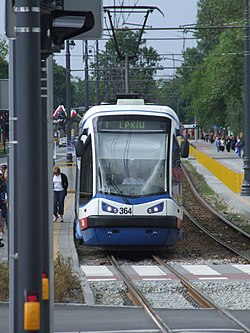Trams in Bydgoszcz
| Trams in Bydgoszcz | |||
|---|---|---|---|
| Tramwaje w Bydgoszczy | |||
 | |||
 PESA 122N tram in Bydgoszcz | |||
| Operation | |||
| Locale | Bydgoszcz, Poland | ||
| Open | 18 May 1888 | ||
| Lines | 11 | ||
| Operator(s) | MZK Bydgoszcz | ||
| Infrastructure | |||
| Track gauge | 1,000 mm (3 ft 3+3⁄8 in) | ||
| Statistics | |||
| Route length | 40.8 km (25.4 mi) | ||
| |||
| Website | http://www.mzk.bydgoszcz.pl/ | ||
Trams in Bydgoszcz is a tram system in Bydgoszcz, Poland that has been in operation since 1888. The system is currently operated by Miejskie Zakłady Komunikacyjne w Bydgoszczy. There are 11 lines with a total line length of 128.05 kilometres (79.57 mi). The system uses 1,000 mm (3 ft 3+3⁄8 in) metre gauge.
History
[edit]Horse Tram
[edit]On the 1st of February, 1888, Ingeniueur Havestadt und Contag first began running a horse-drawn tram line between the Bydgoszcz Main Railway Station and Zbożowy Rynek. 4 years later, In 1892, another horse tram line opened from Koszary Artyleryiskie to Poznańska. [1]
In late 1895, Allgemeine Elektricitäts-Gesellschaft began preparations to electrify the entire tram line. On the 3rd of July, 1896, the first electric tram ran on the Bydgoszcz Tram Network. [2]
1900-1945
[edit]From 1900-1901, German Authorities in Bydgoszcz (Then Bromberg) constructed a third electrified tram line on Jagiellońska Street. After this construction, the entire tram network did not receive any major upgrades or extensions until 1936.
After The Great War, the city of Bydgoszcz fell under the control of the Polish Authorities, and in 1928, the operations of the tram were taken over by the Polish Government. In 1936, a new tram line from Gdanska Street to Bielawny was completed.
The tram network was taken over by German authorities in 1939 after the invasion of Poland, and the Tram network ran as usual until the end of the Second World War. The tram networks were briefly put out of operation after the Red Army took control of the city, However, the entire tram network resumed service before the end of 1945.
1945-1991
[edit]In 1949, a small extension of the tram network was built to Spital Jurasza (The City Hospital). The following year, in 1950, the Western Terminus of the line was extended to Wilczak, where it remains today.
On July 21st, 1953, the largest extension of the tram network was opened, 5 New tram lines were opened south of the Brda river. This tram extension finally linked the majority of the southern side of Bydgoszcz to the northern side. In 1955 and 1957, respectively, new extensions were opened on Gdanska Street and Fordonska Street. In 1959, a new depot was completed on Toruńska Street.
In 1969, the tram network was extended to Bydgoszcz Wshod train Station in the east.
In 1970, Construction of a new bridge carrying tram tracks was completed across the Brda river, the Bridge Pomorski. In 1974, Trams were rerouted out of the historical centre of the city. Also in 1974, the tram line to the city hospital was permanently closed. In 1975 a short extension in the southern side of the city to Magnuszewska Street was completed.
In 1980, The tram network received shipments of Konstal 805Na Trams, Many of these trams still run on the network in the present day. In 1984, an extension of the southern network to Rondo Kujaskie was completed, and in 1989, The extension to the northernmost part of the line (Excluding Fordon) was completed when the network on Gdanska street was extended to Las Gdanski.
1992-Present
[edit]In 1994, MZK Bydgoszcz took over operation of the Tram Network.
In 1998, Tram traffic to the Main Station was closed. This line was rebuilt and reopened in 2012.
Lines
[edit]| Daily | 2, 3, 4, 5, 6, 8, 9, 10, 11 |
|---|---|
| Weekdays only | 1, 7 |
Rolling Stock
[edit]Normal
[edit]| Image | Tramway type | Number | Operation | Low floor | Ref. |
|---|---|---|---|---|---|

|
805Na | 98 | 1980 | 0% | [3] |

|
805Nm | 2 | 2003 (modernised 805Na) | 0% | [3] |

|
122N Tramicus | 2 | 2008 | 100% | [3][4] |

|
122NaB Swing | 27 | 2014 | 100% | [5] |
| 121NaB Swing | 6 | 2017 | 100% | [6] |
Historical
[edit]| Image | Tramway type | Number | Operation | Renovation | Ref. |
|---|---|---|---|---|---|

|
Konstal 5N | 1 | 1960 | 2017 | [3] |

|
Konstal 5ND | 1 | 1960 | 2016 | [7] |

|
Herbrand VNB-125 | 1 | 1896 | 2012 | [8] |

|
Herbrand GE68 | 1 | 1898 | 1986–1988 | [3][8] |

|
Konstal 803N | 1 | 1974 | [8] |
References
[edit]- ^ Marcin, Stiasny (2017). Atlas Sieci Tramwajowych Polski 2017 [Tram Atlas of Poland 2017] (in Polish). Eurosprinter. p. 18-20. Retrieved 28 April 2025.
- ^ "Bydgoszcz Buses & Trams | History".
- ^ a b c d e "Aktualności · mzk.bydgoszcz.pl". mzk.bydgoszcz.pl.
- ^ "Tramwaje typu 122N w Bydgoszczy i Łodzi". Świat Kolei: magazyn sympatyków komunikacji szynowej. (in Polish). 1/2012. Emi-press: 46–47. 1995.
- ^ "Bydgoskie Swingi w komplecie gotowe do jazdy - TransInfo". transinfo.pl (in Polish).
- ^ "Pięćsetny tramwaj Pesy na rynku polskim wyjechał właśnie na tory w Bydgoszczy" (in Polish). Retrieved 2017-09-24.
- ^ ZDMiKP
- ^ a b c "Plan zrównoważonego rozwoju publicznego transportu zbiorowego dla miasta Bydgoszczy" (PDF). mzk.bydgoszcz.pl (in Polish). pp. 92–94. Retrieved 23 September 2015.
External links
[edit]![]() Media related to Trams in Bydgoszcz at Wikimedia Commons
Media related to Trams in Bydgoszcz at Wikimedia Commons












